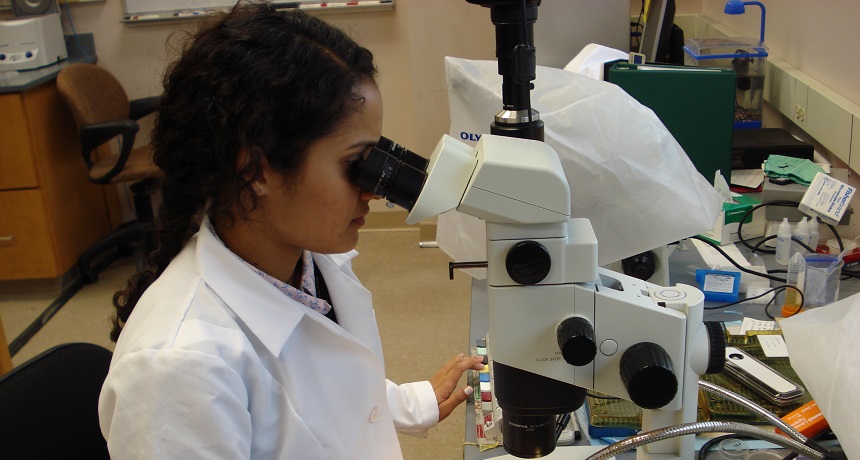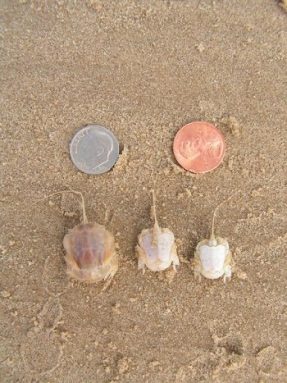Crabby project inspires young scientist
Meera Joseph decided to give research a try, and loved the result

Meera Joseph works the microscope she used to dissect sand crabs, looking for the parasites hidden inside them.
Z. Faulkes/University of Texas Pan Am
“At first I didn’t get why people would want to do research,” recalls Meera Joseph, 19. She’s now a college sophomore in Edinburg, Texas. When she was in high school, Meera already had her goals in mind. She wanted to become a nurse. At some point, however, she started hanging out with kids from a nearby high school, one that specialized in science and engineering. Over time, Meera ran into kids from that school who were interested in research. “They sounded so excited about it,” she recalls. Before long, she says, “I thought I might be able to get into it.”
Meera applied for a spot on a Howard Hughes Medical Institute Science Education Grant at a nearby college (the one she now attends). She won it for the summer of her junior year of high school. Prior to attending, the school sent her information from professors who had volunteered to take high school students into their labs. Meera was immediately drawn to the write-up from Zen Faulkes. He’s a biologist at the University of Texas Pan Am.* His research summary “used easy terms and explained the background of his project,” she recalls. In fact, she notes, it was the only one she understood. It also sounded like a hands on project, one where she could work outside and not be stuck cleaning up after the adult researchers.

Fredensborg studies parasites. So he urged Faulkes to examine the sand crabs for parasites. These are organisms that live off of other species. They live inside or on another organism’s body and feed off it, like a tick or tapeworm. Faulkes recruited Meera to help in their search.
She and Faulkes combed the beaches, collecting sand crabs by the dozen. “We’d start out at six in the morning,” Meera explains. They’d drive about an hour out to South Padre Island, Texas. Then they would shovel beach sand for an hour or two, searching for the wee crabs. “We’d get about 20 on a good day. Then we’d put them in buckets and take them back to the lab.”
Parasites can sometimes change their host’s behavior. Many parasites actually need to have more than one host species. It may lay its eggs in one host, such as a mouse, but grow to adulthood in a cat. In order to get from one host to another, the parasite changes the mouse’s activity. Instead of shy and nervous, the mouse may become bold and curious — and more likely to be out in the open and get eaten by a cat.
Faulkes and Meera wanted to see if any parasites in the crabs might similarly alter how they behave. A college student in the lab, Karina Patiño-Guzman, taught Meera how to dissect crabs. And in short order, Meera found the beach crabs definitely had a parasite problem. Tiny worms called nematodes were living in nearly nine out of every 10 crabs. One crab hosted 108 of these worms!
Meera and Faulkes placed each crab in a tank of water with 75 millimeters (about three inches) of sand at the bottom. Then they timed how long it took the crabs to burrow into the sand. The researchers hypothesized that crabs with more resident worms might dig more slowly or spend more time above the sand. Either situation would leave them unprotected from potential predators.
In fact, Meera and Faulkes showed, nematodes — even a heavy infestation — appear to have no effect on sand burrowing by the crabs. They published their results June 10 in Integrative and Comparative Biology.

The finding had a big effect on Meera. Not only did she get her name on a published scientific paper, she also gave talks about her work. And she learned that she loved research. “My work ethic just jumped,” she says. “I finally experienced doing something because I wanted to do it, instead of because someone told you to do it. I realized there is so much more than you can do than just the bare minimum you need to do to get a good grade.”
Meera now attends the University of Texas Pan Am. She still plans to become a nurse. As she studies, she also is continuing her sand crab research. But the teen is not all work. She is also is learning and teaching Bharata Nayam, a traditional style of Indian dance.
*Zen Faulkes is also a friend of mine, which is how I heard about his research. He also runs a really great series of blogs, including the Better Posters blog. It’s a great resource if you’re a student preparing a research poster.
Follow Eureka! Lab on Twitter
Power Words
biology The study of living things. The scientists who study them are known as biologists.
nematode A type of roundworm, usually found in soil, that can also live within other creatures as a parasite. It is very small, with no eyes, ears or nose.
parasite An organism that gets benefits from another species, called a host, but doesn’t provide it any benefits. Classic examples of parasites include ticks, fleas and tapeworms.
parasitology The scientific study of parasites. People who work in this field are known as parasitologists.
sand crab Any crab in the family Hippoidea. These oval-shaped animals are adapted to burrowing on sandy beaches.